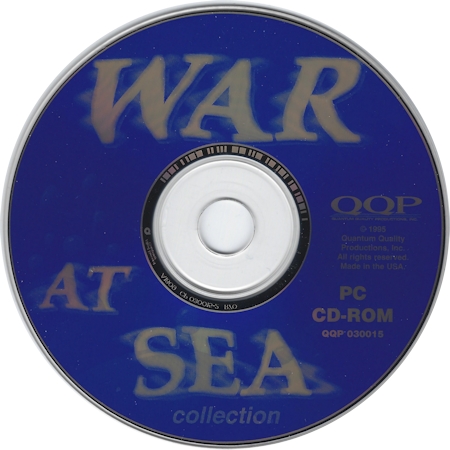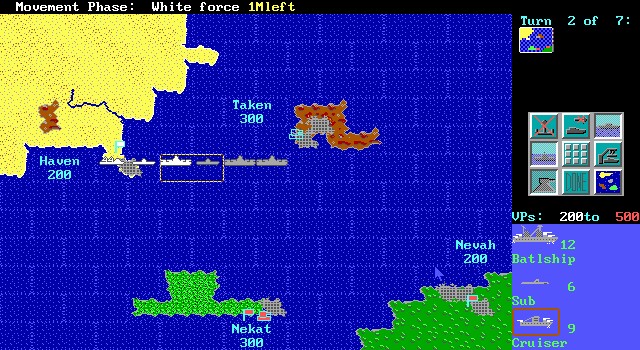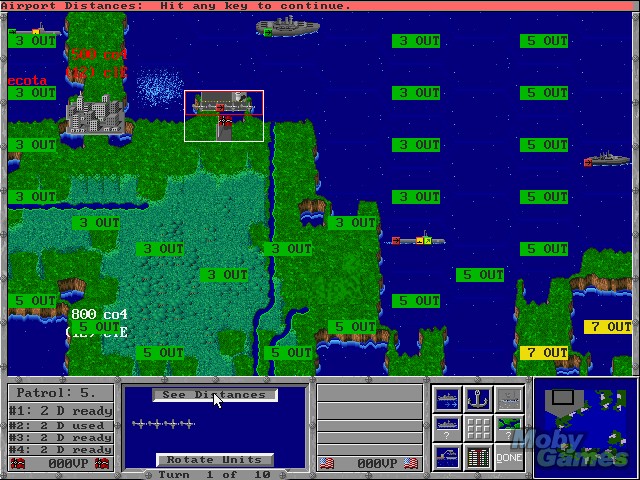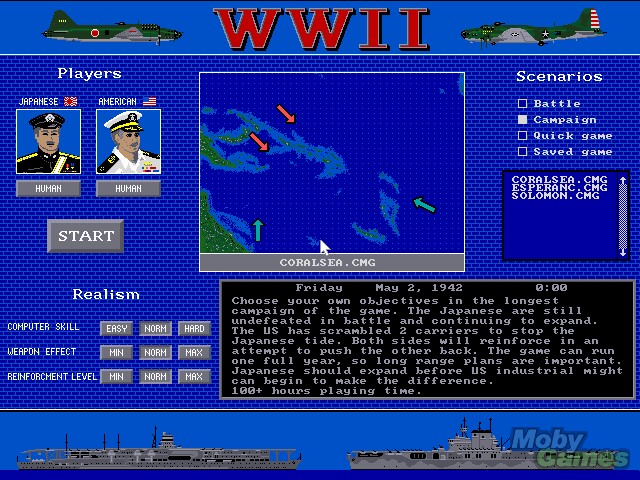
Actual Game
The Lost Admiral
|
The Games
The Lost Admiral
Your first order of the day is to create a new Officer as your player alter-ego. You start out as a lowly Seaman and using preserverace, cunning and brilliant planning earn your "notches" to achieve your place amoung the Admiralty. You earn "notches" by battling your way through either Single Scenarios or Campaigns. The higher you set the difficulty level (1-11), the faster you will see your "notches" increase.
The game comes with 9 maps. Each map roughly corresponds to the 10 preset scenarios. The campaigns consist of several of the scenarios in sequence with the added twist that most campaigns will have a specific mission to accomplish as well as introduce a special super- ship, the Flagship. You may play either as the "red" or "white" player in scenarios and campaigns. Victory conditions, strategy and missions are different depending upon what side you play.
Your objective is not total wanton destruction of enemy, but the taking and holding of territories. Cities are given point values, some higher than others (range is 000-500). You must hold a city for 1 turn to be credited with points. However, it's in only the lower, 200-point cities that you may build new ships as the game progresses. Other than these cities, you are allocated a fixed number of "build points" at game start -- you place the ships you want in your starting home cities until your build points are used up. A "win" consists of a point comparison between the 2 players at the end of the game, but in some cases you may not need more points, just be within a certain percentage.
Combat outcome is fixed. Each ship will do a given amount of damage to any other ship. A handy damage matrix comes with the game. A Carrier adds 1 point of damage when adjacent to a battle square (presumably to simulate air support). When a ship has lost all it's hit points it's sunk. A partially damaged ship may retreat to a friendly-occupied city to repair damage (may be 1 or more turns).
Tactics becomes a game of cat and mouse. You must try to match your ships against the enemys' which are least able to defend them, and conversely keep your vulnerable ships protected against your enemy's strengths. You need to do this while trying to anticipate what the enemy may have lurking in a square just adjacent, but out of sight. Of course you could move your Carrier up to find out, but if that next square holds a couple of Battleships ....
If you're looking for a solid strategy game that's easy to learn, has great depth and balance, a nice intuitive interface, and a great computer opponent, then I can highly recommend this game.
The Grandest Fleet
The Grandest Fleet is a successor to QQP's excellent The Lost Admiral. Very roughly equivalent to "Empire at Sea", you start with a set of ports and a set of naval units and set them off to battle. You can choose which units you start with, and your ports can produce more units over time.
The game keeps track of a set of 'officers'. When you play, you pick an officer to represent you, and your officer will get demoted/promoted based on your performance in the battle. In true QQP fashion, the game keeps abundant records of performance. This is not just chrome - you get a 'flagship' when you fight your battles, and the higher your officers rank, the more powerful your flagship.
You can fight one of three scenarios: either a 'historical' scenario, a randomly generated battle, or a 'campaign', which is essentially a series of linked battles.
Conceptaully, the game is rather like 'Empire at Sea'. You start with one (or more) cities, and explore and expand your way across the map. You get victory points each turn depending on how many cities you have. The game ends either after some number of turns (12, 20, or 32, or until annilhation). In each turn, you move your ships, and then enter a combat phase.
The turn length has a signficant impact on game play. In a 12 turn game the emphasis is on quickly grabbing ground, while in a 32 turn game there's more emphasis on developing and holding your currenti cities - a slower, more methodocal pace.
The game revolves around acquiring, holding, and developing the cities scattered around the map. In The Lost Admiral, cities were very simple entities, which could be conquered merely by moving a single unit into them. No longer! In Fleet, cities are much more important players. First of all, a la Civilization or Railroad Tycoon, cities can now have 'improvements'. Some of these may help directly in combat (a repair yard, for example), some of these grant you victory points (an opera house, for example), and some 'seed' the city so that it will grow more quickly (a 'downtown' or 'convoy', for example). Every turn you get a number of 'culture points' which you use to buy these improvements. The more cities you have, and the larger they are, the more culture they generate.
The cities, important as they are, are auxilliary to the ships, the main units in the game. The units are almost identical to those in The Lost Admiral, with only the addition of a 'minesweeper' and a 'light carrier', but some of them function in signficantly different ways.
First of all, unlike The Lost Admiral, units can now exert 'ranged' fire. While most units can fire only at adjacent enemy units, a cruiser can fire at units 2 away, a battleship at units 3 away, and an aircraft carrier at units up to 5 away. This was probably a result of another design change, namely that you can now only have one unit in a hex (in The Lost Admiral, you could have two).
Aircraft carriers, which were simple 'passive' creatures in The Lost Admiral, are much more realistically modeled in Fleet. They are now very powerful offensive weapons, as their planes pack quite a wallop. They are also very vulnerable, though - a measly 2 hits from most ships will sink them. Just as with bombers, their planes can get shot down, too - make sure you keep your carriers near a friendly airfield so their strength can get replenished. In a significant bug/feature, carrier planes can sink submerged subs, a major change from The Lost Admiral. Battleships have been dramatically enhanced. They are far less vulnerable to subs (they need 8 sub hits to be sunk, as opposed to 3 in The Lost Admiral), and their ranged fire and bombardment abilities make them probably the single most valuable unit in the game.
There's also an entire second set of ships, called 'super ships'. These are delux-o enhanced versions of the regular ships - a 'super battleship' is a real monster, a 'super transport' can invade almost anything, etc., etc. You can't buy these in initial setup, but can buy these during game play once you've developed your cities enough to enable them. I had mixed feelings about this whole 'super ship' business. On the one hand, once cities get big enough you really need super ships to take them. On the other hand, one of The Lost Admirals great strengths was its fine-tuned balance between unit types, which is now thrown out of whack by dumping in 5 more ship types, without, I think, enough thought given to their powers. The 'super transport', for example, is almost totally worthless as by the time it comes on the scene cities are typically armed with 'cruise missiles' which can sink it before it ever gets a chance to invade.
Each turn plays out in a very straightforward way. You move your units one by one. You see enemy units when they show up within the detection range of your units. This range can vary from 1 to 5, depending on the unit. After you've ended your movement, mutual simultaneous combat ensues - you are taken to each eligible unit, and select the enemy to fire on.
This is a pleasant game, particularly for fans of 'Empire' type simulations.
WWII: Battles of the South Pacific
World War II: Battles of the South Pacific is seemingly designed for all levels of war gamers rather than specifically for the die-hard purists that demand full accuracy in all things from a war game. While ships, submarines, aircraft and like hardware are based on historically accurate information, the actual game play and strategy needed to complete scenarios successfully doesn't always emulate proven war tactics. That's not necessarily fatal but expert war gamers will definitely be put off by the loosely structured approach to historical strategies and events. An example of this is the rigid and often incorrect alignment of fleet assignments in relation to each other and tactically preferred formations. Another minor gripe involves the unrealistic power of shore batteries when defending against a bombardment attack. The game has a fairly benign learning curve but winning individual scenarios or long campaigns can be tough or frustrating depending on which side you control. Very few of the battles are balanced which does in many instances replicate historical strengths while exploiting glaring or subtle weaknesses.
Individual victory conditions vary significantly from scenario to scenario and won't always be based on what the player may think they should be so careful attention should be given to a review of them before engaging the enemy. As far as in-depth coverage of the South Pacific war arena, a sufficient assemblage of scenarios are provided with eight quick games and three each of battles and campaigns. Length of game play naturally varies with the type of game selected with the short games playable in less than three hours, the moderate battles in day or so and the campaigns with their one-hour turns lasting significantly longer (days, weeks or even months).
Both the graphics and sound in World War II: Battles of the South Pacific well done for the time. The interface is not difficult and, in fact, makes the actual game play fairly simple and intuitive for novice and expert alike with prolonged play almost certain to build a satisfactory comfort level for the player. The scenarios, which include both historically based as well as hypothetical "what ifs", are thankfully diverse and entertaining. A good range of customizable game play factors are available in setting up most scenarios which keeps the replay value on the high side for repeated attempts of scenario success under varying conditions. This feature becomes important in light of the absence of any sort of scenario editor or builder which seems a bit unusual for these game developers. All things considered, World War II: Battles of the South Pacific offers the player a good, easy -to-use but challenging collection of fairly difficult scenarios to master. Although marginally short on historical accuracy but long on game play, the game offers something to every level of war gamer.
The "lost sheep" of QQP, World War II was released with even less fanfare than QQP's usually modest ad campaigns, perhaps because the company was hyping its more ambitious navy wargame The Grandest Fleet-- a wise choice, considering World War II's abstract gameplay that may not appeal to the majority of wargamers. Still, it's a solid wargame that has all the hallmarks of QQP games: solid AI, fun scenarios and complete player history.








